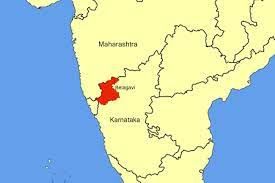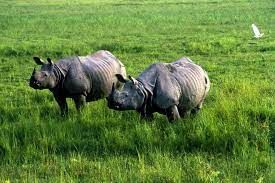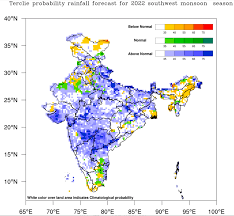UPSC Daily Current Affairs- 13th April 2023 | Current Affairs & Hindu Analysis: Daily, Weekly & Monthly PDF Download
GS-I
IMD predictions of Monsoon
Why in News?
India Meteorological Department (IMD) predicted a borderline-level normal summer monsoon rainfall this year.
About IMD
- It is an agency of the Ministry of Earth Sciences.
- It is the principal agency responsible for meteorological observations, weather forecasting and seismology.
- It is also one of the six Regional Specialised Meteorological Centres of the World Meteorological Organisation.
- IMD releases the long range forecast in two stages in April and June.
Predictions by IMD
- Normal to below normal rainfall:
- The rainfall during the June-September period is likely to be 96% of the long-term average Period.
- Normal to below normal rainfall in some areas of north west India and some parts of west central India and some pockets of north east India.
- El Nino impact:
- The El Nino is the key factor responsible for the relatively less rainfall this year.
- Since 2019, India has been under the influence of the converse ‘La Nina’ and therefore is getting substantial monsoon rains.
- The El Nino event, triggered by warm water in the equatorial Pacific, can affect weather patterns worldwide and in India, El Nino linked to drier conditions and reduced rainfall.
- Current La Nina:
- The current La Lina conditions, which is usually favourable to monsoon, has changed to neutral over the equatorial Pacific region.
IMD Categorisation Method of Monsoon
- Long Period Average (LPA):
- LPA of rainfall is the rainfall recorded over a particular region for a given interval (like month or season) averaged over a long period like 30 years, 50-years etc.
- It acts as a benchmark while forecasting the quantitative rainfall for that region for a specific month or season.
- Categories of Rainfall:
- Large Excess: ≥60% of long period average (LPA).
- Excess: 20% to 59% of long period average (LPA).
- Normal: -19% to +19% of long period average (LPA).
- Deficient: -59% to -20% of long period average (LPA).
- Large Deficient: -99% to -60% of long period average (LPA).
- Predicting the Monsoon: Monsoon season is from June to September in India as a whole, the long period average (LPA) is 88 cm and standard deviation is 9cm (about 10% of mean value).
- Therefore, when the rainfall averaged over the country as a whole is within ±10% from its LPA or 90% to 110% of LPA, the rainfall is said to be “normal” and when the rainfall is <90% of LPA it is considered to be below normal and when it is >110% of LPA, the rainfall is said to be “above normal”.
Monsoon & its onset
- A monsoon is a seasonal change in the direction of the prevailing, or strongest, winds of a region.
- The monsoon that starts around the first week of June, making the first landfall in Kerala.
- From October to November, the retreating monsoon or the Northeast monsoon sets in, and brings rain to the eastern coast of India, especially Tamil Nadu.
- Various factors such as the availability of energy in the atmosphere, the intertropical convergence zone, the Coriolis effect and jet streams, play a role in facilitating the southwest monsoons.
Effects of Monsoon on Indian Subcontinent
- Agriculture & Economy: Adequate and timely monsoon showers are vital for India’s agriculture sector, the main source of livelihood for some 60% of its population and which accounts for about 18% of the economy.
- Nearly half of India's farmland, which has no irrigation cover, depends on annual June-September rains to grow crops such as rice, corn, cane, cotton and soybeans.
- Monsoon uncertainty can pose potential risk to the economy.
- Rivers: The monsoon brings water and sediment not only to Indian rivers but also to rivers in China, Bangladesh, etc.
Source: The Hindu
Good Friday Agreement

Why in News?
The US President Joe Biden is going to visit Belfast, the capital of Northern Ireland, to mark the 25th anniversary of the Good Friday Agreement.
Good Friday Agreement
- The Good Friday Agreement was signed on April 10, 1998, between factions of Northern Ireland, and the governments of Britain and Ireland.
- It ended 30 years of the violence known as ‘The Troubles’, has been hailed as a model deal to end long-standing conflicts, and fetched a joint Nobel peace prize for David Trimble and John Hume, then leaders of the two opposing parties in Northern Ireland.
- It was signed to end decades of violence in Northern Ireland among those who wished to remain with the United Kingdom (UK) and those who wanted to join Ireland.
What were The Troubles?
- Northern Ireland was created in May 1921 by partitioning Ireland, and consists of the six northeastern counties of the island.
- In 1922, the rest of Ireland gained independence from the British (today’s Republic of Ireland, with its capital in Dublin). Northern Ireland remained with the United Kingdom, but tensions simmered between the side loyal to the Crown, mostly Protestants, and the faction wanting to join the Republic, mostly Catholics.
- By the 1960s, the Protestants had become more powerful and the Catholics started facing discrimination.
- The violence erupted between both factions – The Troubles, claiming the lives of more than 3,500 people.
What were the terms of the Good Friday Agreement?
- Northern Ireland would remain part of the UK, but could join Ireland if, in a referendum, a majority of people on both sides voted for it.
- People born in Northern Ireland could have Irish or British nationality or both.
- Northern Ireland would get a new government, which would have powers over local matters, while the UK government would look after security, foreign policy, tax laws, immigration rules, etc.
- On May 22 1998, a referendum was held in Ireland and Northern Ireland, and the agreement was approved by 94% of voters in Ireland and 71% in Northern Ireland.
What is the status 25 years on?
- The most important achievement of the Good Friday Agreement has been an end to bloodshed and enduring peace in the region.
- Brexit has thrown a spanner in the works. Ireland has been paralysed for more than a year.
- Britain’s intelligence agency (MI5), recently increased the threat level in Northern Ireland from domestic terrorism to “severe”.
- Several pro-Union political parties in N. Ireland (like the DUP) started boycotting the agreement.
- To solve this crisis, the UK and the EU recently reached an agreement known as the Windsor Framework.
Why is the US so enthusiastic about the Agreement?
- The US had played a key part in negotiations building up to the agreement.
- The USA’s current President (Biden) is descended from Irish immigrants (second after John F Kennedy) and is vocally proud of his Irish heritage.
Source: Indian Express
GS-II
Pradhan Mantri Fasal Bima Yojana
Why in News?
Recently, Prime Minister Narendra Modi expressed happiness over the success of the Pradhan Mantri Fasal Bima Yojana.
About Pradhan Mantri Fasal Bima Yojana.:-
- The Pradhan Mantri Fasal Bima Yojana (PMFBY) was launched in 2016.
- Administered by: Ministry of Agriculture
- Objective: PMFBY insures farmers against all non-preventable natural risks from pre-sowing to post-harvest.
- It is an insurance service scheme for farmers for their yields which aims to reduce the premium burden on farmers and ensure early settlement of crop assurance claims for the full insured sum.
- Implemented by: Empanelled general insurance companies
Coverage:-
- The Scheme covers all Food & Oilseeds crops and Annual Commercial/Horticultural Crops for which past yield data is available and for which a requisite number of Crop Cutting Experiments (CCEs) are being conducted under General Crop Estimation Survey (GCES).
Objectives:-
- To provide insurance coverage and financial support to the farmers in the event of failure of any of the notified crops as a result of natural calamities, pests & diseases
- To stabilise the income of farmers to ensure their continuance in farming
- To encourage farmers to adopt innovative and modern agricultural practices
- To ensure the flow of credit to the agriculture sector
Source: AIR
What is the Belagavi border dispute?

Why in News?
The Supreme Court recently adjourned the hearing on the Belagavi border dispute case.
About Belagavi border dispute:
- It is an interstate dispute between Karnataka and Maharashtra over the control of Belagavi, a border town in Karnataka.
- History:
- It has its roots in the State Reorganization Act of 1956, which aimed at reorganizing the states along linguistic lines.
- At the time of India’s independence, Belagavi was part of the Bombay state that had included parts of present-day Karnataka.
- After the implementation of the Act, Belagavi (previously Belgaum) became a part of Karnataka.
- On May 1, 1960, Maharashtra claimed that 865 villages, including Belagavi, Carvar and Nipani, should be part of Maharashtra and not Karnataka.
- However, Karnataka said it will not part with any part of its territory.
- Mahajan Commission:
- It was set up by the Union government on October 25, 1966, to solve the dispute.
- The panel turned down Maharashtra’s claim over Belagavi and also recommended that 247 villages/places, including Jatt, Akkalkote and Solapur, be made part of Karnataka, and 264 villages /places, including Nippani, Khanapur and Nandagad, to be in Maharashtra.
- However, the commission’s report was outrightly rejected by Maharashtra. Meanwhile, Karnataka saw the commission ruling in its favour.
- Present Status:
- The Maharashtra government filed a plea in the Supreme Court challenging the State Reorganisation Act, 1956, in 2004. It demanded 865 villages and places from five Karnataka districts to be merged with the state.
- Meanwhile, Karnataka changed the name of Belgaum to Belagavi and made it the second capital of the state.
- The issue has been pending before the Supreme Court since 2004.
- Karnataka contends that only Parliament can decide the state borders and not the Supreme Court. It cites Article 3 of the Indian Constitution while doing so.
- On the other hand, Maharashtra cites Article 131 and claims the apex court has jurisdiction in cases of disputes in which the Union government and the states are involved.
Source: PIB
GS-III
Framework for acceptance of Green Deposits of Regulated Entities (RE)

Why in News?
The Reserve Bank of India (RBI) recently announced the framework for the acceptance of green deposits of regulated entities (RE).
About Framework for acceptance of Green Deposits of Regulated Entities (RE):
- Purpose: It is intended to encourage regulated entities (usually banks and non-banking financial institutions) to offer green deposits to customers, protect the interest of the depositors, aid customers in achieving their sustainability agenda, address greenwashing concerns and help augment the flow of credit to green activities/projects.
- It will apply to all scheduled commercial banks, including small finance banks and deposit-taking non-banking finance companies such as housing finance firms.
- The framework shall come into effect from June 1, 2023.
- Key features of the framework:
- The entities will issue green deposits as cumulative or non-cumulative deposits.
- On maturity, they can be renewed or withdrawn.
- The green deposits shall be denominated in Indian rupees only.
- All conditions applicable to other public deposits will also be applicable to green deposits.
- The allocation of funds raised from green deposits will be based on the official Indian green taxonomy, which is yet to be finalised.
- However, as an interim measure, REs shall be required to allocate the proceeds raised through green deposits in the categories such as Renewable energy, Energy efficiency, Clean Transportation, Sustainable water and waste management etc.
- Nuclear power generation, direct waste incineration, landfill projects and hydropower plants larger than 25 MW are among the uses that are prohibited using funds raised via green deposits.
- The allocation of funds raised through green deposits by REs during a financial year shall be subject to an independent Third-Party Verification/Assurance, which shall be done on an annual basis.
- The REs, with the assistance of external firms, will also annually assess the impact associated with the funds.
What is a Green Deposit?
- It is an interest-bearing deposit received by regulated entities for a fixed period.
- The proceeds are earmarked for being allocated towards green finance.
Source: The Hindu
Conservation of wildlife in India

Why in News?
The Prime Minister of India launched International Big Cats Alliance on Commemoration of 50 years of ‘Project Tiger’ recently. The conservation of wildlife fauna is a complex task that involves addressing various challenges.
- According to the recent data by the Wildlife Crime Control Bureau (WCCB) and State Forest and Police Authorities, in the past three years (2018-2020), about 2054 cases were registered for killing or illegal trafficking of wild animals in India.
About International Big Cats Alliance (IBCA):
- IBCA will focus on the protection and conservation of seven major big cats of the world such as tiger, lion, leopard, snow leopard, puma, jaguar and cheetah in collaboration with countries harbouring these species.
- Membership to the alliance will be open to 97 “range” countries, which contain the natural habitat of these big cats, as well as other interested nations, international organizations, etc.
Challenges posed during the conservation of wildlife fauna:
- Habitat Loss: One of the most significant challenges in conserving endangered wildlife is habitat loss.
- With growing urbanization, deforestation, and development activities, the natural habitats of wildlife species are shrinking rapidly.
- For e.g. Habitat loss faced by Great Indian Bustard in India.
- Poaching: Poaching of wildlife for their skins, bones, and other body parts is another significant challenge faced by conservation efforts.
- Poachers often kill wildlife species for illegal trade, which drives the species to the brink of extinction.
- For example – the Tusk of Elephants, Horns of Rhinoceros.
- Human-Wildlife Conflict: As the human population continues to expand, conflicts between wildlife and humans also increase.
- Wildlife often ventures into human settlements in search of food and water, leading to conflicts and sometimes causing loss of life and property damage.
- For example – Instances of Elephants being killed while crossing railway tracks.
- Inadequate funding and resources: Conservation efforts require substantial resources, including funding, staff, and equipment.
- In India, conservation organizations often struggle to secure adequate resources to carry out their work effectively.
- Climate change: Climate change can have significant impacts on wildlife habitats and migration patterns, leading to changes in population dynamics and species composition.
- Invasive species: The introduction of invasive species into ecosystems can disrupt natural ecological processes and threaten native species.
- Example Invasive species such as water hyacinth and Mimosa are great threats to Kaziranga NP.
- Poor law enforcement: Enforcement of laws and regulations designed to protect endangered species can be lax, which undermines conservation efforts.
- Lack of coordination and cooperation: Conservation efforts can be undermined by a lack of coordination and cooperation between different organizations and stakeholders involved in conservation efforts.
Importance of wildlife:
- Ecological importance: Wildlife helps in maintaining the eco-logical balance of nature. Killing of carnivores leads to an increase in the number of herbivores which in turn affect the forest vegetation, thus due to lack of food in the forest they come out from the forest to agriculture land and destroy our crops.
- This makes us know that wildlife helps in maintaining ecological balance even by being predators of each other .
- Economic importance: The wild life can be used to earn money. Wild plant products like food, medicine, timber, fibres, etc. are of economic value and the wild animal products such as meat, medicines, hide, ivory, lac, silk, etc. are of tremendous economic value.
- Investigatory importance: Some wild organisms are used for scientific experiments such as to test effect of medicine.
- Conservation of biological diversities: By conserving wildlife, diversity in the environment can be conserved.
- According to some scientists an ecosystem with more diversity is more stable.
- Importance in agriculture: Wild organisms are very important for modern agriculture.
- Production of new hybrid variety using wild plants
- Production of better hybrid variety of animals used for agriculture using wild animals
- New species of plants and animals can be produced by them
- Religion of wild: Many animal species have spiritual significance in different cultures around the world, and they and their products may be used as sacred objects in religious rituals.
- Eco Tourism: Many nations have established their tourism sector around their natural wildlife.
Constitutional Provisions
- Article 48 A in the Directive Principles of State policy, mandates that the State shall endeavour to protect and improve the environment and to safeguard the forests and wildlife of the country.
- Article 51 A (g) of the Constitution states that it shall be the fundamental duty of every citizen to protect and improve the natural environment including forests and Wildlife.
- The 42nd Amendment Act, 1976, Forests and Protection of Wild Animals and Birds was transferred from State to Concurrent List.
Steps taken by government for conservation of Fauna:
- Wildlife Protection Act 1972: Protected Areas like National Parks, Biodiversity Reserves, etc. were created
- Project Tiger: Initiated in 1972. It helped in the conservation of both tigers and the entire ecosystem.
- Project Elephant: Initiated in 1992 with the aim of conserving elephants and their habitat and of migratory routes by developing scientific and planned management measures.
- Crocodile Conservation Project: The main objectives of the crocodile project is to protect the remaining population of crocodiles and their natural habitat by establishing sanctuaries.
- UNDP Sea Turtle Project: To conserve the Olive Ridley Turtles. Initiated by Wildlife Institute of India, Dehradun as the Implementing Agency in 1999.
- Cheetah Reintroduction Programme in Kuno Palpur sanctuary in Madhya Pradesh from Namibia.
- Vulture Conservation: National Board for Wildlife (NBWL) has cleared a plan for conserving vultures.
- India Rhino Vision (IRV) 2020: The goal of IRV2020 was to increase the rhino population in Assam to 3,000 by establishing populations in new areas.
- Wetland (Conservation and Management) Rules 2010 have been drafted to protect wetlands in India.
Way Forward:
Public awareness and education must play an essential part in teaching an environment of compassion in protecting animals with sustainable solutions to address these issues. All these need to be discussed collectively at a global scale to make a positive impact.
There is dire need to be mindful of tackling increased urbanization, rising temperatures, and ecotourism, which are negatively contributing and fuelling to affect wildlife. The Indian government has taken significant measures to address these challenges and protect endangered wildlife, including tigers, and the recent improvement in the tiger population is a testament to the success of these efforts.
Source: PIB
Mission Arikompan
Why in News?
Mission Arikompan is likely to be delayed as Kerala Forest department is yet to get a satellite radio collar.
What is Mission Arikompan?
- The forest department has initiated ‘Mission Arikompan’, an operation to capture the rogue tusker by the name of Arikompan.
- The forest department has come up with a plan to capture it with tranquilizer shots and train it to be a ‘kumki’, a captive elephant used for operations against rogue elephants.
Parambikulam Tiger Reserve
- Parambikulam Tiger Reserve is located in Palakkad district and Thrissur district of Kerala.
- It is in the Sungam range of hills between the Anaimalai Hills and Nelliyampathy Hills.
- The Western Ghats, Anaimalai Sub-Cluster, including all of Parambikulam Wildlife Sanctuary, has been declared by the UNESCO World Heritage Committee as a World Heritage Site
- The Tiger Reserve is the home of four different tribes of indigenous peoples including the Kadar, Malasar, Muduvar and Mala Malasar.
- This sanctuary is referred to as the "state capital for the massive gaur" by wildlife experts.
Source: Indian Express
|
38 videos|5288 docs|1117 tests
|
FAQs on UPSC Daily Current Affairs- 13th April 2023 - Current Affairs & Hindu Analysis: Daily, Weekly & Monthly
| 1. What is the significance of GS-I, GS-II, and GS-III in UPSC exams? |  |
| 2. How are the UPSC General Studies papers structured? |  |
| 3. What are the key topics covered under GS-I, GS-II, and GS-III? |  |
| 4. How can candidates prepare effectively for the UPSC General Studies papers? |  |
| 5. What is the weightage of the General Studies papers in the UPSC examination? |  |



















